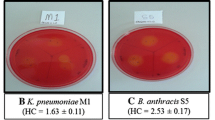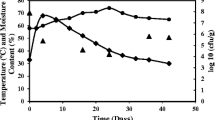Abstract
The demand for enzymes is increasing continuously due to their applications in various avenues. The pectin-hydrolyzing bacteria, Cellulomonas sp. and Bacillus sp., isolated from forest soil have the potential to produce industrially important enzymes (pectinase, PGase, Cellulase, and xylanase). However, these bacteria have different optimal cultural conditions for pectinase production. The optimal cultural conditions for Cellulomonas sp. were room temperature (25–26℃), pH 7, 1% inoculum volume, and 1.5% citrus pectin with 8.82 ± 0.92 U/mL pectinase activity. And Bacillus sp. illustrated the highest pectinase activity (12.35 ± 0.72 U/mL) at room temperature, pH 10, 1% inoculum volume, and 1.5% pectin concentration. Among the different agro-wastes, the orange peel was found to be the best substrate for pectinase, PGase, and cellulase activity whereas barley straw for xylanase activity. Further, Cellulomonas sp. and Bacillus sp. illustrated higher pectinase activity from commercial pectin compared to orange peel showing their preference for commercial citrus pectin. In addition, the optimization by the Box-Behnken design increased pectinase activity for Cellulomonas sp., while a noticeable increase in activity was not observed in Bacillus sp. Besides, all the agro-wastes exploited in this study can be used for pectinase, PGase, and xylanase production but not cellulase. The study revealed that each bacteria has its specific optimal conditions and there is a variation in the capacity of utilizing the various lignocellulosic biomass.






Similar content being viewed by others
Data availability
The datasets generated during and/or analyzed during the current study are available from corresponding author on reasonable request.
References
Aaisha GA, Barate DL (2016) Isolation and identification of pectinolytic bacteria from soil samples of Akola region, India. Int J Curr Microbiol App Sci 5:514–521
Ajobiewe HF, Ajobiewe JO, Mbagwu TT et al (2019) Demonstration of pectinase enzyme activity from soil isolated Bacillus spp. in Karu Nasarawa State of Nigeria using orange peels substrate. https://doi.org/10.5923/j.microbiology.20190901.02
Amadi OC, Awodiran IP, Moneke AN et al (2022) Concurrent production of cellulase, xylanase, pectinase and immobilization by combined Cross-linked enzyme aggregate strategy- advancing tri-enzyme biocatalysis. Bioresour Technol Reports. https://doi.org/10.1016/j.biteb.2022.101019
Bharathiraja S, Suriya J, Krishnan M et al (2017) Production of enzymes from agricultural wastes and their potential industrial applications. In: Kim SK , Toldrá F, Advances in Food and Nutrition Research, 1st edn. Academic Press, p 125–148
Bibi N, Ali S, Tabassum R (2016) Statistical optimization of pectinase biosynthesis from orange peel by Bacillus licheniformis using submerged fermentation. Waste Biomass Valorization 7:467–481. https://doi.org/10.1007/s12649-015-9470-4
El EHA, Elsayed EA, Suhaimi N et al (2018) Bioprocess optimization for pectinase production using Aspergillus niger in a submerged cultivation system. BMC Biotechnol 18:1–13
Govindaraji PK, Vuppu S (2020) Characterisation of pectin and optimization of pectinase enzyme from novel Streptomyces fumigatiscleroticus VIT-SP4 for drug delivery and concrete crack-healing applications: An eco-friendly approach. Saudi J Biol Sci. https://doi.org/10.1016/j.sjbs.2020.07.024
Hachemi F, Nouani S, Benchabane T (2015) Bioconversion of oranges wastes for pectinase production using Aspergillus niger under solid state fermentation. Int J Bioeng Life Sci 9:911–916
Haile S, Ayele A (2022) Pectinase from microorganisms and its industrial applications. Sci World J 2022. https://doi.org/10.1155/2022/1881305
Handa S, Sharma N, Pathania S (2016) Multiple parameter optimization for maximization of pectinase production by Rhizopus sp. C4 under solid state fermentation. Fermentation 2:9. https://doi.org/10.3390/fermentation2020010
Ibrahim AM, Hamouda RA, El-Naggar NEA, Al-Shakankery FM (2021) Bioprocess development for enhanced endoglucanase production by newly isolated bacteria, purification, characterization and in-vitro efficacy as anti-biofilm of Pseudomonas aeruginosa. Sci Rep 11:1–24. https://doi.org/10.1038/s41598-021-87901-9
Ketipally R, Ram MR (2018) Optimization of pectinase production by Aspergillus oryzae RR 103. Curr Agric Res J 6:37–44
Laothanachareon T, Bunterngsook B, Champreda V (2022) Profiling multi-enzyme activities of Aspergillus niger strains growing on various agro-industrial residues. 3 Biotech 12:1–16. https://doi.org/10.1007/s13205-021-03086-y
Limkar MB, Pawar SV, Rathod VK (2019) Statistical optimization of xylanase and alkaline protease co-production by Bacillus spp using Box-Behnken Design under submerged fermentation using wheat bran as a substrate. Biocatal Agric Biotechnol 17:455–464. https://doi.org/10.1016/j.bcab.2018.12.008
Mihajlovski K, Buntić A, Milić M et al (2020) From agricultural waste to biofuel: enzymatic potential of a bacterial isolate Streptomyces fulvissimus CKS7 for bioethanol production. Waste Biomass Valorization. https://doi.org/10.1007/s12649-020-00960-3
Miller GL (1959) Use of dinitrosalicylic acid reagent for determination of reducing sugar. Anal Chem 31:426–428. https://doi.org/10.1021/ac60147a030
Mussatto SI, Ballesteros LF, Martins S, Teixeira JA (2012) Use of agro-industrial wastes in solid-state fermentation processes. Industrial waste; Kuan-yeow Show (Ed.) Croatia, ISBN: 978–953- 51–0253–3, InTech
Oumer OJ, Abate D (2018a) Screening and molecular identification of pectinase producing microbes from coffee pulp. Biomed Res Int. https://doi.org/10.1155/2018/2961767
Oumer OJ, Abate D (2018b) Comparative studies of pectinase production by Bacillus subtilis strain Btk 27 in submerged and solid-state fermentations. Biomed Res Int 2018:10. https://doi.org/10.1155/2018/1514795
Ozzeybek M, Cekmecelioglu D (2022) Formulation of apple pomace, orange peel, and hazelnut shell mix for co-production of bacterial pectinase and cellulase enzymes by mixture design method. Biomass Convers Biorefinery. https://doi.org/10.1007/s13399-022-02409-0
Panda SK, Mishra SS, Kayitesi E, Ray RC (2016) Microbial-processing of fruit and vegetable wastes for production of vital enzymes and organic acids: Biotechnology and scopes. Environ Res 146:161–172. https://doi.org/10.1016/j.envres.2015.12.035
Ramírez-Tapias YA, Rivero CW, Britos CN, Trelles JA (2015) Alkaline and thermostable polygalacturonase from Streptomyces halstedii ATCC 10897 with applications in waste waters. Biocatal Agric Biotechnol 4:221–228. https://doi.org/10.1016/j.bcab.2014.12.004
Ravindran R, Hassan SS, Williams GA, Jaiswal AK (2018) A review on bioconversion of agro-industrial wastes to industrially important enzymes. Bioengineering 5:1–20. https://doi.org/10.3390/bioengineering5040093
Reddy Chandra MP, Saritha KV (2016) Effects of the culture media optimization on pectinase production by Enterobacter sp PSTB-1. 3 Biotech. https://doi.org/10.1007/s13205-016-0502-y
Rehman HU, Aman A, Nawaz MA, Qader SAU (2015) Characterization of pectin degrading polygalacturonase produced by Bacillus licheniformis KIBGE-IB21. Food Hydrocoll 43:819–824. https://doi.org/10.1016/j.foodhyd.2014.08.018
Roy K, Dey S, Uddin MK et al (2018) Extracellular pectinase from a novel bacterium Chryseobacterium indologenes strain SD and Its application in fruit juice clarification. Enzyme Res 2018:1–7. https://doi.org/10.1155/2018/3859752
Sadh PK, Duhan S, Duhan JS (2018) Agro-industrial wastes and their utilization using solid state fermentation: a review. Bioresour Bioprocess 5:1–15. https://doi.org/10.1186/s40643-017-0187-z
Shrestha S, Mokale AL, Zhang J, Qin W (2020) Different facets of lignocellulosic biomass including pectin and its perspectives. Waste and Biomass Valorization. https://doi.org/10.1007/s12649-020-01305-w
Shrestha S, Khatiwada JR, Zhang X et al (2021) Screening and molecular identification of novel pectinolytic bacteria from forest soil. Fermentation 7:12. https://doi.org/10.3390/fermentation7010040
Shrestha S, Chio C, Khatiwada JR et al (2022a) Formulation of the agro-waste mixture for multi-enzyme ( pectinase, xylanase, and cellulase ) production by mixture design method exploiting. Bioresour Technol Reports 19:6
Shrestha S, Chio C, Khatiwada JR et al (2022b) Optimization of multiple enzymes production by fermentation using lipid-producing Bacillus sp. Front Microbiol. https://doi.org/10.3389/fmicb.2022.1049692
https://www.blueweaveconsulting.com/report/global-industrial-enzymes-market world enzyme
Acknowledgements
The authors would like to acknowledge all the individuals who directly or indirectly helped to complete this research. This work was supported by the Natural Sciences and Engineering Research Council of Canada (RGPIN-2017-05366) to Wensheng Qin and the Ontario Graduate Scholarship to Sarita Shrestha.
Funding
This work was supported by the Natural Sciences and Engineering Research Council of Canada (RGPIN-2017–05366) to Wensheng Qin and the Ontario Graduate Scholarship to Sarita Shrestha.
Author information
Authors and Affiliations
Contributions
The manuscript was designed, performed, analyzed and written initial draft by SS. JRK and other authors helped in revision of the manuscript. WQ provided resources for the study, commented on and helped revise the manuscript. All authors read and approved the final manuscript for the publication.
Corresponding author
Ethics declarations
Conflict of interest
The authors have no relevant financial or non-financial interests to disclose.
Additional information
Communicated by PANKAJ BHATT.
Publisher's Note
Springer Nature remains neutral with regard to jurisdictional claims in published maps and institutional affiliations.
Rights and permissions
Springer Nature or its licensor (e.g. a society or other partner) holds exclusive rights to this article under a publishing agreement with the author(s) or other rightsholder(s); author self-archiving of the accepted manuscript version of this article is solely governed by the terms of such publishing agreement and applicable law.
About this article
Cite this article
Shrestha, S., Khatiwada, J.R., Kognou, A.L.M. et al. A comparative study of Cellulomonas sp. and Bacillus sp. in utilizing lignocellulosic biomass as feedstocks for enzyme production. Arch Microbiol 205, 130 (2023). https://doi.org/10.1007/s00203-023-03470-7
Received:
Revised:
Accepted:
Published:
DOI: https://doi.org/10.1007/s00203-023-03470-7




